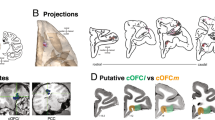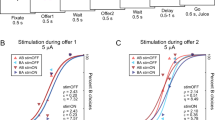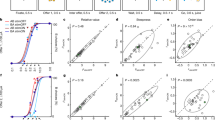Abstract
Economic choice entails assigning values to the available options and is impaired by lesions to the orbitofrontal cortex (OFC). Recent results show that some neurons in the OFC encode the values that monkeys (Macaca mulatta) assign to different goods when they choose between them. A broad and fundamental question is how this neuronal representation of value depends on the behavioral context. Here we show that neuronal responses in the OFC are typically invariant for changes of menu. In other words, the activity of a neuron in response to one particular good usually does not depend on what other goods are available at the same time. Neurons in the OFC encode economic value, not relative preference. The fact that their responses are menu invariant suggests that transitivity, a fundamental trait of economic choice, may be rooted in the activity of individual neurons.
This is a preview of subscription content, access via your institution
Access options
Subscribe to this journal
Receive 12 print issues and online access
$209.00 per year
only $17.42 per issue
Buy this article
- Purchase on Springer Link
- Instant access to full article PDF
Prices may be subject to local taxes which are calculated during checkout





Similar content being viewed by others
References
Fellows, L.K. The cognitive neuroscience of human decision making: a review and conceptual framework. Behav. Cogn. Neurosci. Rev. 3, 159–172 (2004).
Glimcher, P.W., Dorris, M.C. & Bayer, H.M. Physiological utility theory and the neuroeconomics of choice. Games Econ. Behav. 52, 213–256 (2005).
Padoa-Schioppa, C., Jandolo, L. & Visalberghi, E. Multi-stage mental process for economic choice in capuchins. Cognition 99, B1–B13 (2006).
Ongur, D. & Price, J.L. The organization of networks within the orbital and medial prefrontal cortex of rats, monkeys and humans. Cereb. Cortex 10, 206–219 (2000).
Pasquier, F. & Petit, H. Frontotemporal dementia: its rediscovery. Eur. Neurol. 38, 1–6 (1997).
Hodges, J.R. Frontotemporal dementia (Pick's disease): clinical features and assessment. Neurology 56, S6–S10 (2001).
Izquierdo, A., Suda, R.K. & Murray, E.A. Bilateral orbital prefrontal cortex lesions in rhesus monkeys disrupt choices guided by both reward value and reward contingency. J. Neurosci. 24, 7540–7548 (2004).
Fellows, L.K. & Farah, M.J. The role of ventromedial prefrontal cortex in decision making: judgment under uncertainty or judgment per se? Cereb. Cortex 17, 2669–2674 (2007).
Everitt, B.J. & Robbins, T.W. Neural systems of reinforcement for drug addiction: from actions to habits to compulsion. Nat. Neurosci. 8, 1481–1489 (2005).
Bechara, A., Tranel, D., Damasio, H. & Damasio, A.R. Failure to respond autonomically to anticipated future outcomes following damage to prefrontal cortex. Cereb. Cortex 6, 215–225 (1996).
Rahman, S., Sahakian, B.J., Hodges, J.R., Rogers, R.D. & Robbins, T.W. Specific cognitive deficits in mild frontal variant of frontotemporal dementia. Brain 122, 1469–1493 (1999).
Koenigs, M. & Tranel, D. Irrational economic decision-making after ventromedial prefrontal damage: evidence from the Ultimatum Game. J. Neurosci. 27, 951–956 (2007).
Arana, F.S. et al. Dissociable contributions of the human amygdala and orbitofrontal cortex to incentive motivation and goal selection. J. Neurosci. 23, 9632–9638 (2003).
Blair, K. et al. Choosing the lesser of two evils, the better of two goods: specifying the roles of ventromedial prefrontal cortex and dorsal anterior cingulate in object choice. J. Neurosci. 26, 11379–11386 (2006).
O'Doherty, J.P. Reward representations and reward-related learning in the human brain: insights from neuroimaging. Curr. Opin. Neurobiol. 14, 769–776 (2004).
Knutson, B., Taylor, J., Kaufman, M., Peterson, R. & Glover, G. Distributed neural representation of expected value. J. Neurosci. 25, 4806–4812 (2005).
Pritchard, T.C. et al. Gustatory neural responses in the medial orbitofrontal cortex of the old world monkey. J. Neurosci. 25, 6047–6056 (2005).
Wallis, J.D. & Miller, E.K. Neuronal activity in primate dorsolateral and orbital prefrontal cortex during performance of a reward preference task. Eur. J. Neurosci. 18, 2069–2081 (2003).
Roesch, M.R. & Olson, C.R. Neuronal activity related to reward value and motivation in primate frontal cortex. Science 304, 307–310 (2004).
Rolls, E.T., Sienkiewicz, Z.J. & Yaxley, S. Hunger modulates the responses to gustatory stimuli of single neurons in the caudolateral orbitofrontal cortex of the macaque monkey. Eur. J. Neurosci. 1, 53–60 (1989).
Roesch, M.R. & Olson, C.R. Neuronal activity dependent on anticipated and elapsed delay in macaque prefrontal cortex, frontal and supplementary eye fields and premotor cortex. J. Neurophysiol. 94, 1469–1497 (2005).
Padoa-Schioppa, C. & Assad, J.A. Neurons in orbitofrontal cortex encode economic value. Nature 441, 223–226 (2006).
Montague, P.R. & Berns, G.S. Neural economics and the biological substrates of valuation. Neuron 36, 265–284 (2002).
Tremblay, L. & Schultz, W. Relative reward preference in primate orbitofrontal cortex. Nature 398, 704–708 (1999).
Kreps, D.M. A Course in Microeconomic Theory, 850 (Princeton University Press, Princeton, New Jersey, 1990).
Allingham, M. Choice Theory: A Very Short Introduction, 127 (Oxford University Press, Oxford, 2002).
Tobler, P.N., Fiorillo, C.D. & Schultz, W. Adaptive coding of reward value by dopamine neurons. Science 307, 1642–1645 (2005).
Cromwell, H.C., Hassani, O.K. & Schultz, W. Relative reward processing in primate striatum. Exp. Brain Res. 162, 520–525 (2005).
Hosokawa, T., Kato, K., Inoue, M. & Mikami, A. Neurons in the macaque orbitofrontal cortex code relative preference of both rewarding and aversive outcomes. Neurosci. Res. 57, 434–445 (2007).
Logan, F.A. Decision-making by rats: delay versus amount of reward. J. Comp. Physiol. Psychol. 59, 1–12 (1965).
Campione, J.C. Transitivity and choice behavior. J. Exp. Child Psychol. 7, 387–399 (1969).
Mazur, J.E. & Coe, D. Tests of transitivity in choices between fixed and variable reinforcer delays. J. Exp. Anal. Behav. 47, 287–297 (1987).
Choi, S., Fisman, R., Gale, D. & Kariv, S. Consistency and heterogeneity of individual behavior under uncertainty. Am. Econ. Rev. (in the press).
Tversky, A. The intransitivity of preferences. Psychol. Rev. 76, 31–48 (1969).
Navarick, D.J. & Fantino, E. Transitivity as a property of choice. J. Exp. Anal. Behav. 18, 389–401 (1972).
Shafir, S. Intransitivity of preferences in honey bees: support for 'comparative' evaluation of foraging options. Anim. Behav. 48, 55–67 (1994).
Shafir, S. Context-dependent violations of rational choice in honeybees (Apis mellifera) and gray jays (Perisoreus canadensis). Behav. Ecol. Sociobiol. 51, 180–187 (2002).
Tversky, A. & Simonson, I. Context-dependent preferences. Manage. Sci. 39, 117–185 (1993).
Grace, R.C. Violations of transitivity: Implications for a theory of contextual choice. J. Exp. Anal. Behav. 60, 185–201 (1993).
Price, J.L. Prefrontal cortical networks related to visceral function and mood. Ann. NY Acad. Sci. 877, 383–396 (1999).
Sugrue, L.P., Corrado, G.S. & Newsome, W.T. Matching behavior and the representation of value in the parietal cortex. Science 304, 1782–1787 (2004).
Padoa-Schioppa, C. Orbitofrontal cortex and the computation of economic value. Ann. NY Acad. Sci. published online 14 August 2007 (doi:10.1196/annals.1401.011).
LeDoux, J.E. Emotion circuits in the brain. Annu. Rev. Neurosci. 23, 155–184 (2000).
Critchley, H.D. Neural mechanisms of autonomic, affective and cognitive integration. J. Comp. Neurol. 493, 154–166 (2005).
Carmichael, S.T. & Price, J.L. Sensory and premotor connections of the orbital and medial prefrontal cortex of macaque monkeys. J. Comp. Neurol. 363, 642–664 (1995).
Dorris, M.C. & Glimcher, P.W. Activity in posterior parietal cortex is correlated with the relative subjective desirability of action. Neuron 44, 365–378 (2004).
Judge, S.J., Richmond, B.J. & Chu, F.C. Implantation of magnetic search coils for measurement of eye position: an improved method. Vision Res. 20, 535–538 (1980).
Luce, R.D. Individual Choice Behavior: A Theoretical Analysis (Wiley, New York, 1959).
Acknowledgements
We gratefully acknowledge A. Rustichini for many insightful discussions. We also thank A. Bisin, J. Maunsell, P. Glimcher and W. Schultz for helpful comments on earlier versions of the manuscript. This work was supported by a post-doctoral fellowship from the Harvard Mind/Brain/Behavior Initiative, by a Pathway to Independence Award from the National Institute of Mental Health to C.P.-S. (grant number K99-MH080852) and by a grant from the National Institute of Neurological Disorders and Stroke to J.A.A. (grant number R01-NS41000).
Author information
Authors and Affiliations
Contributions
C.P.-S. designed the experiment, collected and analyzed the data, and wrote the manuscript. J.A.A. assisted in the study and in manuscript preparation.
Corresponding author
Supplementary information
Supplementary Text and Figures
Supplementary Figures 1 and 2, and Data (PDF 442 kb)
Rights and permissions
About this article
Cite this article
Padoa-Schioppa, C., Assad, J. The representation of economic value in the orbitofrontal cortex is invariant for changes of menu. Nat Neurosci 11, 95–102 (2008). https://doi.org/10.1038/nn2020
Received:
Accepted:
Published:
Issue Date:
DOI: https://doi.org/10.1038/nn2020
This article is cited by
-
Electrophysiological population dynamics reveal context dependencies during decision making in human frontal cortex
Nature Communications (2023)
-
Seeking Pleasure, Finding Trouble: Functions and Dysfunctions of Trait Sensation Seeking
Current Addiction Reports (2023)
-
Emotion, motivation, decision-making, the orbitofrontal cortex, anterior cingulate cortex, and the amygdala
Brain Structure and Function (2023)
-
Individuals with ventromedial frontal damage display unstable but transitive preferences during decision making
Nature Communications (2022)
-
Decision Making: a Theoretical Review
Integrative Psychological and Behavioral Science (2022)



